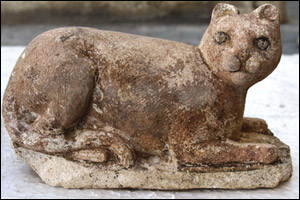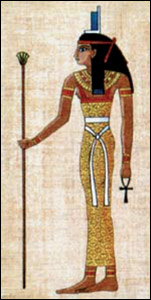|
[Variety]
Mythical gods of Egypt
Egypt was a museum of different cults, from the period of the old
kingdom (4000 BC to first century AD), till the advent of Christianity
and Islam. The old Egyptian Nile civilisation has been predominantly
governed or motivated by the mythical powers of the gods, goddesses and
deities. There were so many gods, goddesses and deities in the Nile
civilisation.
|

Cats were highly venerated. |
The Egyptians worshipped and venerated them with great respect and
devotion. This respect and devotion was the most significant civilised
phenomenon in the lives of Egyptians at that time.
A team of Egyptian archaeologists led by Mohamed Abdel Maqsood
discovered many artefacts during an excavation project carried out at
the old Alexandrian Royal quarters. They discovered an old temple
dedicated to Goddess Bast - the Cat-goddess in the heart of Alexandria
which was believed to be nearly 2000 years old. It was founded by
Alexander the Great in the Fourth Century BC. The Bast statue or the
cat-goddess was the most significant discovery among the artefacts. The
Egyptian Supreme Council of Antiquities made a declaration confirming
its historical authenticity on January 19 this year.
|

The recently discovered artefact |
The discovery of the statue Bast also referred to as Basat or Bastet
confirms that the veneration of the cat-goddess had been practised by
the people right from the 15th Century BC up to the Ptolamiac Dynasty in
the Fourth Century.BC
The newly discovered Temple (2009-2010) was said to belong to Queen
Berenice, the wife of King Ptolomy III.
The Egyptian chief archaeologist, Shai Howass says as a large number
of stones is missing on the excavated site, it must have been used by
the people as a quarry for a long period. The modern Alexandria had been
built squarely on the top of the ruins of the classical-era-city. Many
of its gardens, palaces and libraries still remain under the present
port-city of Alexandria.
The gods and goddesses of that time were depicted in animal or human
form or with a human body and an animal head.
This was the role model of the manifestation of Egyptian gods at that
time, especially related to the Nile civilisation. There were gods and
goddesses in the image of lionesses, jackals, crocodiles, falcons, cows
and cats in Egypt.
|

Some of the animal - human gods |
 |
| Egyptian
goddesses |
|
 |
The famous cat-goddess is called Bast or Baset, the falcon god is
called God Horus, the cow god God Honums the crocodile - headed god is
called God Sobek and the jackal god is called God Anubis.
Isis is a female human god. While God Thoth is a male human god. All
these gods manifested different concepts.
God Horus for protection, God-Best for joy, music dancing, health,
healing and perfume and God Anubis for protection, God Isis for love,
affection and beauty and God Thoth for astrology, writing and
creativity. God Amun and Ra for power and energy. God Osiris for life,
death and rebirth of all living things. This was the culture of life and
belief of the pre-religious era of Egypt.
The cat god Bast was a national God of Egypt in 3200BC. There were so
many other local gods too. Once King Akhamenthop (1370 B.C) made a
declaration prohibiting polytheism. He ordered and commanded the people
to follow one god and that was God Atons, the sun-disk god. The Bast
which joined the pantheon of gods in the Middle Kingdom era, was
depicted as a woman with a cat's head.
It was portrayed with a sacred basket in the new kingdom era. Cats
were revered highly in Egypt because they killed mice, vermins and
serpents which were a threat to the food supply. Egyptian historians say
that even killing a cat was a punishable offence, at that time; the
death penalty was the probable verdict.
Domesticated cats enjoyed all the comfort on par with the family
members. The dead cats were mummified and buried. The family members who
died were buried along side the cat's burial pits.
According to historical findings, 300,000 mummified cats were
discovered near the per-Bast temple. The Father of History, Herodotus
says when a cat in a family died the Egyptian shaved their eye-brows and
took the body to Bubastis to embalm. It is said that there are some
settlers in the Nile hinterland still who worship the Goddess cat, Bast
or Baset. It continues today through the khemetic reconstructionalist
religion, in Egypt.
K. W. Chandrarathne.
Retired Government Teacher. |

